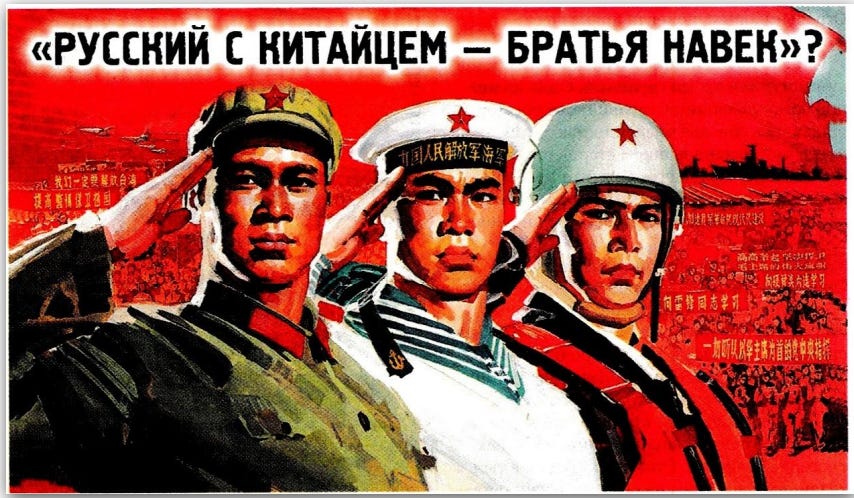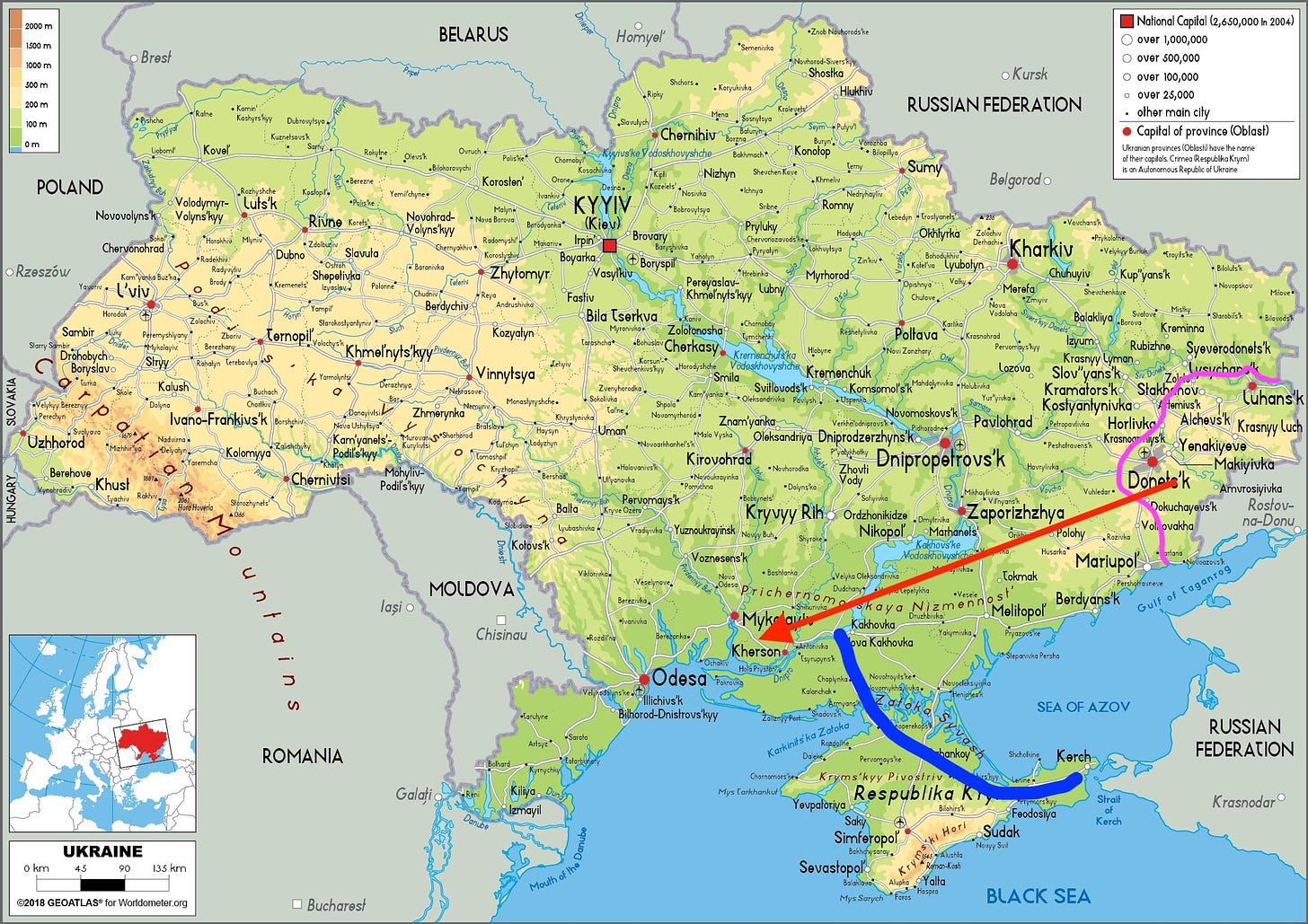“Russian and Chinese—brothers forever”
This was the beginning of a song that sounded in Moscow in 1949 on the eve of Mao Zedong’s visit to the Soviet Union. I would not be surprised if soon the Kremlin asks some of the poets to slightly update its text—the mention of Mao and Stalin had disappeared in the time of Nikita Khrushchev, and all that remains to do is replace the words “Soviet Union” and the Russian military units will be able to march to these sounds.
Defense Ministers of Russia and China Sergei Shoigu and Wei Fenghe approved a roadmap for military cooperation for 2021-2025. “They expressed a mutual focus on stepping up the conduct of strategic military exercises and joint patrols by the armed forces of the Russian Federation and the PRC,” the Russian Defense Ministry said in a press release.
The main topic of the talks was the summing up of this year’s joint maritime and air patrols in the Asia-Pacific region. During the meeting, the ministers also discussed the U.S. military activity in the Asia-Pacific. Sergei Shoigu said that in November, 10 US strategic bombers worked out nuclear weapons against Russia during their exercises.
No default, says Minfin. Hmmm…
Five days after Rusnano warned its creditors about a possible default, the Russian Ministry of Finance acted to calm the market.
“Debt obligations of the state company Rusnano, secured by state guarantees, will be fulfilled,” the Ministry promised. The press release stated that “currently, the Russian government is working out mechanisms to increase the efficiency of Rusnano, including the spin-off of the portfolio of historical projects...the company’s obligations, secured by the state, are guaranteed”.
Most of Rusnano’s bonds began rising in value. Even bonds maturing on December 1 increased by 6%—however, this is little consolation for their owners: The yield of these securities today exceeds 3000%—although the Minfin said nothing about the fate of debts not guaranteed by the government. The ministry also did not mention whether the budget is looking to support the company in paying coupon yields on bonds, which the government does not guarantee.
War is possible, believes Mr. Market
On Monday, U.S. State Department spokesman Ned Price told reporters, “We’re concerned, knowing that, of course, we can’t speak to the intentions of the Russian Federation, but we are concerned because we are familiar with the playbook that Moscow has used in the past.” “And if you look back, as the Secretary [U.S. Secretary of State Antony Blinken] has said, to 2014, you saw Moscow amass forces on the border and then claim a pretextual provocation that caused them to go into Crimea and to eastern Ukraine,” Price added.
The intense flow produced by the Western media about the allegedly planned military invasion of Ukraine by Russia caused the strongest sell-off on the Russian market in the past 18 months. By the end of the trading day on Monday, leading indices fell 7%-9.5% compared to the middle of the previous week. The dollar continued to strengthen; this process began in mid-October—over the month, it rose by 8%—which, however, can be explained by a 6% decrease in world oil prices during this time. It is unlikely that a panic flight of capital from Russia will start—the comments of financial analysts indicated an overly emotional market reaction and predicted the recovery of the upward trend. Bingo! By the end of Tuesday, the market regained half of its losses.
I do not think that Putin is preparing for a new invasion of Ukraine. The seizure of a small part of the neighbor’s territory—for example, the city of Mariupol with its metallurgical plants and port—will not change the strategic situation in eastern Ukraine. An alternative option for the offensive is the advance of the Russian army to the Kherson-Mykolaiv area, aiming to obtain control over the North Crimean Canal, which supplies Crimea with water and which the Ukrainian authorities have blocked since the beginning of the occupation of the peninsula. But for such an operation, 90,000 soldiers concentrated at the borders of Ukraine is not enough.
But it doesn’t matter what I think. It is essential to recognize that the U.S. and European politicians and investors do not believe the Kremlin’s reassurances that Russia is not looking for a military operation against Ukraine, considering this a highly likely scenario. And they make decisions based on their interests and principles.
No comments
The Russian Security Council secretary, Nikolai Patrushev, is one of the ideologues of the Putin regime. His speeches on domestic and foreign policy help to understand the logic of thinking and actions of the Kremlin. His last interview on the Belarusian-Polish border strongly correlates with the unprecedentedly aggressive and rude interview for the BBC by the Belarusian dictator, Alexander Lukashenko. Here are the main points of Patrushev’s interview:
“Having wrought chaos and destruction in the Middle East and North Africa, Westerners are now wondering why the population of these countries is moving en masse to other regions.”
“Kurds, mainly, have formed groups that organize and ensure the transport of migrants to Europe. Using transit through Belarus has become a lucrative and highly cynical business.”
“...business is well organized in the Polish border zone, where migrants who have broken through the Belarusian-Polish border are transferred to Germany for a certain amount of money.”
“What is happening today on the Belarusian-Polish border can also be regarded as a result of external pressure on Belarus. They failed to destroy the country’s leadership, plunge the country into chaos, into protest marches; now they are trying to flood the state with migrants, undermining the social protection and health care system.”
“Having de facto established its protectorate in Ukraine, the West destroyed the economy of this country, brought society to powerlessness, and particular layers of the population to poverty. At any moment in Ukraine, it can blaze so that millions of Ukrainians will run to seek shelter in other places.”
I see no reason to comment on this.
Costly occupation
The occupation of Crimea costs the Kremlin, according to my estimates, about $5 billion a year. Of course, these expenses do not threaten financial stability and do not pose problems for the federal budget. On the other hand, Western economic sanctions limit opportunities for Russian and foreign companies to invest in Crimea, which leads to new problems.
Chernomorneftegaz is the only company that produces gas on the peninsula and owns regional gas pipelines. After the annexation of Crimea by Russia, gas production fell by half and continues to shrink; to supply the economy and the households, the company must purchase gas on the exchange. Russia’s existing gas price regulation system fixes gas prices for consumers but allows free pricing on exchanges. In 2021, Chernomorneftegaz buys twice as much gas from the exchange as it produces itself; the sale of gas according to the rules fixed by the Russian government (fixed tariffs and payment within 35 days) increases losses for the company every day, due to the rise in free price on the exchange.
To solve its financial problems, Chernomorneftegaz informed its industrial consumers that they would be forcibly transferred to new rules for paying for consumption. Those rules are in line with exchange trading rules—100% advance payment for gas and the price of the exchange. As an alternative, Chernomorneftegaz said consumers are free to purchase gas directly on the exchange, contracting the company for gas transportation only.
The largest gas consumers in Crimea are power generation companies crying loudly against this because their tariffs are also strictly limited by the government. The purchase of gas at free prices on a prepayment basis will lead to their losses. However, due to the sanctions restrictions, they cannot find alternative suppliers or independently purchase gas on the exchange.
The CEO of KrymTETs, Taras Tsely, said: “We have sent letters to various major gas suppliers, but no one wants to work with Crimea—we are a sanctioned region.” The manager adds that it is also tricky to buy gas on the exchange independently: First, the company will not be allowed there, because it is under sanctions, and second, “no one will allow the market price of gas to be included in the tariffs.”
Attempt to reset the economy
Ferrous metallurgy is the backbone of the economy of the separatist-controlled territories in eastern Ukraine, but its situation worsens from year to year. In 2020, for example, the production of pig iron, steel, and rolled products in the territory of the unrecognized Luhansk People’s Republic (LPR) fell by 55%-60%. The reason is apparent: Few want to buy products from the companies whose owners have been replaced by force. The economic downturn presents the Kremlin with a choice. On the one hand, it is possible to increase the flows of financial aid to the separatists. Because Russia does not integrate these regions, maintaining the status quo is not very expensive; funds are required to finance current expenses without investing in infrastructure (as is done in Crimea). But, on the other hand, the Kremlin cannot ensure complete control over the use of money transferred to separatists, whose requests are growing every month.
The alternative the Kremlin has chosen is to try to reset the local economy. To this end, last week, President Putin signed a decree on facilitating the access of goods produced in these territories to the Russian market. The ink had not dried and the government had not issued any documents prescribed by the presidential decree when the Alchevsk Metallurgical Combine, located in the LPR territory, resumed the thick-sheet steelwork rolling shop. The company said that these products “are in a certain demand” in the Russian market. After the presidential decree was issued, the company had “the opportunity to conclude contracts and sell this product in the Russian Federation.”
In June 2021, the heads of the DPR and LPR announced that all metallurgical enterprises in the region came under the control of a “new investor,” Evgeny Yurchenko, who has been controlling coal mining in this region since 2017.
According to experts, rolled products from the LPR and DPR may occupy up to 15% of the Russian market. Its main competitive advantage is significant discounts on the market price.
Of course, products from the LPR/DPR to the Russian market will complicate the life of the largest Russian private metallurgical companies. Still, Vladimir Putin constantly requires businessmen to show their patriotism. Maybe, that is a chance to do it?
Don’t worry! Be happy!
The authorities of St. Petersburg, the second-largest city in Russia with a population of 5 million people, hasn’t suppressed the latest wave of the pandemic yet. Nevertheless, the governor of the town, Alexander Beglov, followed the inconsistent information policy of the Kremlin. He said that the city is preparing an extensive New Year’s holidays program, with more than 500 citywide events. Of course, according to the governor, the holiday format will depend on the COVID situation and the level of vaccination of city residents. But it’s time to forget about the threat of a pandemic and start thinking about good things.
Dear subscribers! You will receive a shorter version of Behind the Iron Curtain this Thursday, November 25—I have no intention of distracting your Thanksgiving. As well, you will receive nothing the next day—Black Friday makes everyone really busy.
I still plan to provide Saturday’s essay.





